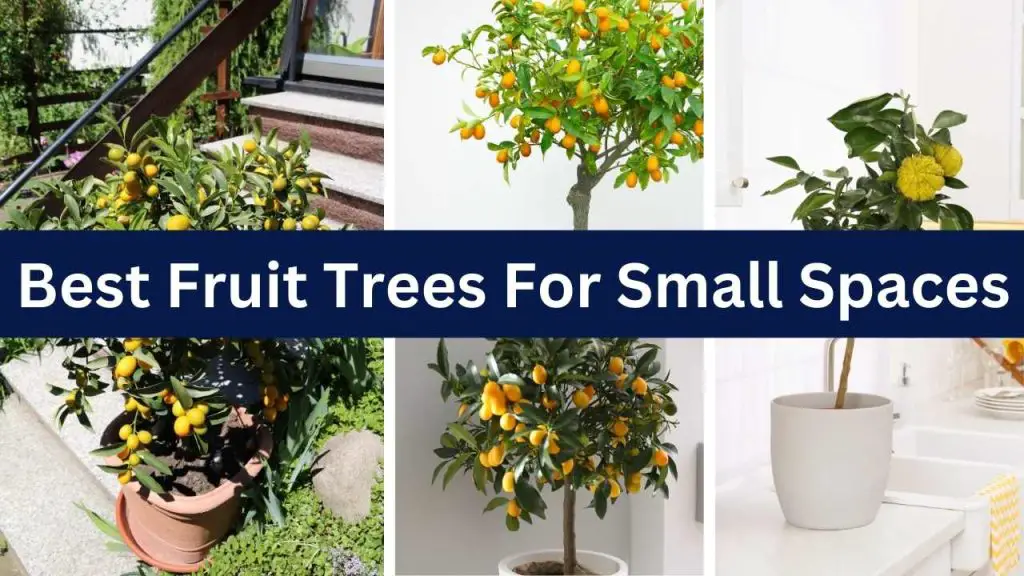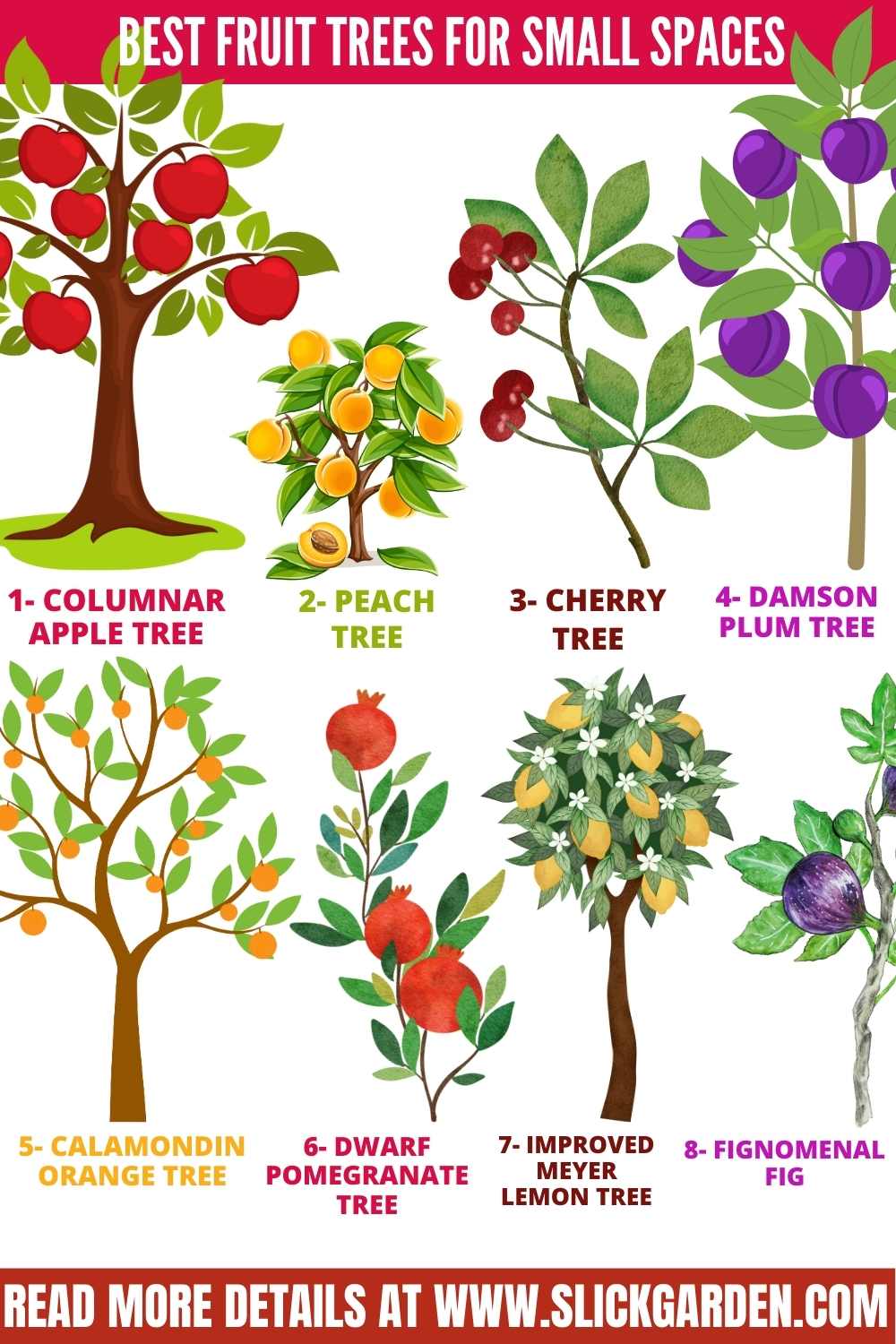The gardeners who have a small growing area think that they can’t grow fruit trees. Now modern advancement in the field of gardening has solved this problem and they can enjoy the fresh fruits from their own grown trees in small spaces.

Now fruit trees can be part of any small Garden or backyard. Although small spaces can restrict the growth of fruit trees and reduce the size of the fruit, it is possible to grow your favourite fruits in small spaces.
Can We Grow Fruit Trees In Small Spaces?
The right selection of varieties and proper care make it possible to grow fruit trees in confined spaces. Following are some tips that will help you in growing fruit trees.
- Select compact or dwarf varieties so they can easily adjust in the small spaces you have. Dwarf varieties are ideal for small spaces because when they mature you can easily manage them. These varieties even grow in containers or large pots.
- If you have a very small space such as balconies or a patio then you must grow fruit trees in containers or large pots. Make sure the size of the container must be large and it has drainage holes. Now select those varieties that are well suited for container gardening. In a large container, the roots of the fruit tree can easily adjust and your tree will become more strong.
- For small spaces, you must consider espalier for growing fruit trees. In this method, you will train your trees against a wall or trellis. In this way, your fruit trees will take up less horizontal space. You can easily train pears, apples, or even peach trees using this beneficial technique.
- Regular pruning keeps the size of the fruit tree according to the space you have. This will also help to control the growth and make your tree more compact. It is better to prune the tree during that dormant season. Remove the excess branches so it will help to maintain the airflow and your plant will be able to produce more fruit.
- You should never neglect the sunlight for the production of fruit. Your location for fruit trees must be sunny because sufficient sunlight helps to thrive and produce abundant fruit. When your fruit tree receives the required amount of sunlight then you will be able to pick fresh and juicy fruit.
Best Fruit Trees Options For Small Spaces
The selection of the right variety of fruit trees for small spaces is a very important task. You must choose those fruit trees that can easily grow in your climate.
If you are growing to plant your fruit trees in containers then you can take them inside your house during the cold days. Make sure the variety you are choosing must be disease resistant and self-fertile.

1- COLUMNAR APPLE TREE
A columnar apple tree is perfect for your limited space. You can easily grow it because it needs less maintenance than standard-size apple trees.
You should not compromise on the location of the columnar apple tree for producing fruit. These trees must receive 6 to 8 hours of sunlight.
Loamy soil is perfect but if you are growing them in a large container then you must use high-quality potting mix so your apple tree gets all the required nutrients according to its need.
This dwarf tree needs 2 inches of water each week. You must avoid overwatering and never let the soil soggy. Columnar apple trees will not produce fruit if they are facing the risk of nutrient deficiencies.
It is better to apply the right fertilizer in springtime and midsummer. This apple tree can grow up to 9 ft. If columnar trees grow taller then they need proper support.
2- PEACH TREE
The best dwarf varieties of peach trees that can easily adjust in the smallest spaces are Contender, Redhaven, Elberta, and Cresthaven. For small spaces, you must choose a small and compact variety.
Dwarf varieties also produce delicious peaches for you. The maximum height of these dwarf trees is only 5 to 7 ft so you can easily manage them.
A sunny location, well-drained fertile soil, and proper watering help to produce fresh and juicy peaches for you. The quality of the fruit depends upon the sunlight the peach tree receives.
If you are using well-drained soil then the roots of the peach tree will keep healthy and strong. You can add organic material to make the soil richer for dwarf peach trees.
It is better to use 10-10-10 fertilizer every few weeks, especially during the growing season. When you see the colour of the fruit changing it means your fruit is fully developed. The harvesting time of peaches starts from late June to August.
3- CHERRY TREE
The best dwarf varieties of cherries are Lapins and Stella. A sunny spot for your cherry trees because when they receive full sun exposure they produce sweet cherries for you.
Well-drained soil is needed for perfect growth. The maximum height of a dwarf cherry tree can be 5 to 10 feet. If you are growing dwarf cherry trees in a pot then the size of the pot must be 18 inches.
When your dwarf cherry tree is established in its permanent location then it needs care. High humidity is not suitable for cherry trees. Cherry trees start producing fruit when their age is about 4 years.
But dwarf cherry trees produce fruit within 3 years. Dwarf trees produce 10 to 15 quarts of cherries in the growing season.
The perfect time for planting the cherry trees is in early Spring or late fall. You should maintain the frequency of water and never leave the plant dry.
To maintain the moisture level of the soil you can apply a layer of mulch around the tree. Cherries are the favourite of birds so you can protect your fruit with wildlife-safe netting.
4- DAMSON PLUM TREE
With proper care, maintenance, and attention your damson plum tree easily grows in a small space. You should not compromise on a sunny location because sunlight helps to produce fresh and juicy plums for you.
To make your soil more rich you can add organic matter such as compost or peat moss to improve the quality of the soil. The poor drainage of the soil hinders the root development of plum trees.
The Damson plum tree needs regular watering. You should keep the soil moist and avoid overwatering. With the help of your finger, you can check the moisture level of the soil if it feels dry then water it at once to prevent your fruit tree from wilting.
It is better to maintain a frequency of water according to the weather condition and moisture of your area. For instance, if the weather is too hot then your plant needs more water than winter.
To make your Damson plum tree more compact, pruning must be done regularly. It will control the growth and allow fresh air. This will also reduce the danger of diseases.
You can apply a balanced and slow-release fertilizer in spring to make the soil richer in nutrients that are required by Damson plum trees.
Keep Reading:
- How To Grow Grapefruit Trees In Pots?
- 20 Fruit Trees To Grow From Cuttings
- How To Grow Fruit Trees From Seeds?
- Tropical Fruits That Can Grow In Pots
5- CALAMONDIN ORANGE TREE
Oranges are citrus fruits and their tree is the best choice for your fruit garden. Calamondin orange trees can be grown in small spaces because their maximum height can be eight feet.
This variety of orange trees can also be grown indoors. In the first few months, the orange tree needs more water. If the weather is too hot then you should increase the frequency of water when winter comes. You can water the orange tree when you feel the soil is dry.
6 to 8 hours of direct sunlight is necessary for fruit production. Make sure your Calamondin tree is growing in a sunny place. You can feed calamondin orange trees in the summer.
You will get all the instructions for using fertilizer on the packet. Prune the tree when you feel it is overgrown. Removing damage, disease or dead branches makes your tree more healthy.
When the fruit turns orange then this is the right time of picking. You can gently twist the fruit and pick it.
6- DWARF POMEGRANATE TREE
If you select a dwarf pomegranate tree for growing in your small space then you must train and prune them as this will help to keep the size of the tree according to your space.
Pruning also encourages flowering and fruiting. You can buy a young dwarf tree pomegranate tree from any local nursery or gardening store.
Consistent watering is needed for the healthier growth of pomegranate trees. Keep the soil moist and never let it dry. But avoid overwatering because it can cause root rot which is not good for your tree.
The perfect time for feeding the tree is in spring and summer. You can use all-purpose liquid fertilizer for making the soil more rich. The maximum height of this tree can be 4 ft and the harvesting period is from summer to fall.
7- IMPROVED MEYER LEMON TREE
The next tree that is included in our list for small spaces is the improved Meyer lemon tree. This is a self-fertile hybrid variety. The maximum height of this tree is from 5 to 7 ft.
The lemon tree is always ideal for confined spaces. The flowers of this tree are full of fragrance and produce juicy and aromatic lemons.
You can even grow it in large pots and it will produce a large crop of rounded fruits. A lemon tree can tolerate frost. Pruning helps to keep the fruit tree in the desired size according to your area. The perfect time for pruning is in late winter to early spring.
8- FIGNOMENAL FIG
The last tree that is included in our list is the fignomenal tree. This tree will bring a Mediterranean vibe to your growing area. This tree is ideal for confined spaces and is easily grown in any backyard.
The maximum height of this tree is 5 ft which is perfect for small spaces. You can even grow it indoors. This is a self-fertile variety that produces figs year-round. The fruit produced by the fignomenal dwarf fig tree is dark brown. The colour of the flesh is pink-red with a sweet flavour.
Make sure the soil must be well drained and you choose a fully sunny location for your dwarf fig tree. Even watering is regular for this dwarf fig tree.
Especially in the spring the plant needs more water because of the new growth. To maintain the moisture level of the soil you can apply a layer of mulch around the fig tree. Feeding is necessary to keep your fruit tree more healthy. You can use slow-release fertilizer in the spring.
